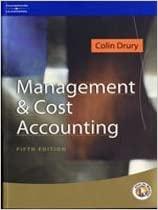Advanced: FIFO stock valuation, standard costing and cost-plus pricing Campex Ltd uses a dyeing and waterproofing process
Question:
Advanced: FIFO stock valuation, standard costing and cost-plus pricing Campex Ltd uses a dyeing and waterproofing process for its fabrics which are later made up into tents and other outdoor pursuit items, or sold to other manufacturers. Each roll of fabric is subject to the same process, with dyeing and waterproofing materials being added at specific times in the process. The direct labour costs are incurred uniformly throughout the process.
Inspection of the fabric for spoilage can take place only at the end of the process when it can be determined whether or not there has been any spoilage. Amounts of up to 10% of good output are acceptable as normal spoilage. Any abnormal spoilage is treated as a period loss. Some spoiled fabric can be reworked and it is saved up until a batch of 500 rolls can be reprocessed.
The reworking costs are charged to process overheads, and any reworked goods will not usually need the full cost of conversion spent on them. The work in progress is valued using the FIFO method.
At the beginning of the month of June the work in progress in the dyeing and waterproofing depart¬ ment was 1000 rolls which were valued at £12000 direct materials and £4620 direct labour. The work in progress has had all the direct materials added, but was only 60% complete as far as the direct labour was concerned. During the month 5650 rolls were started from new, and 500 rolls were reworked. The rolls being reworked require 60% of direct materials and 50% of direct labour to bring them up to standard. By the end of the month 550 rolls had been found to be spoiled. The work in progress at the end of the month amounted to 800 rolls of which 80% were complete for direct materials and 40% were complete for direct labour. All other rolls were completed satisfactorily and transferred to stores to await further processing. The costs for June were direct materials £72085, direct labour £11718. The departmental overhead recovered was £3.5 for every £1 direct labour, whilst actual overhead expenditure amounted to £34110 for the month (excluding the reworking costs).
Requirements:
(a) Prepare a schedule showing the actual equiva¬
lent units processed for each cost element in the processing department for the month of June and the costs per roll for the direct material used and the direct labour and applied overheads. (7 marks)
(b) Prepare a schedule showing the allocation of the costs of production to the various cost headings for the month of June, including the value of closing work in progress using the FIFO method. (6 marks)
(c) Discuss the usefulness of converting the system used above to a standard cost based system. (4 marks)
(d) Comment on the use of the actual costs you have computed above in
(a) and
(b) for product pricing. (4 marks)
(e) Comment briefly on the implications of using replacement costs in a process costing system including valuation of month end work in progress.
Step by Step Answer:






